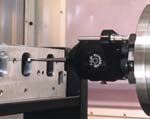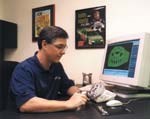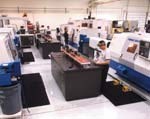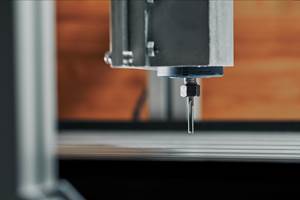Racing Team Shifts Into Reverse Engineering
When the Joe Gibbs Racing team went shopping for a reverse engineering system five years ago, it looked at a variety of technologies. But the team decided to put this on-machine scanning system in the driver's seat of its reverse engineering program.
The Joe Gibbs Racing (Huntersville, North Carolina) operation is miles ahead of yesteryear's race garage in terms of size, capabilities and technology. Gibbs currently employs 120 in a 145,000-square-foot facility, which includes separate departments for CNC machining, engine design/build, body and paint, and equipment transport. The team has access to a wide variety of CAD/CAM computer software packages as well as a flow bench simulator to test CAD port designs before cutting prototypes.
The CNC department is stocked with eight machines churning out a wide variety of critical car components. But because cylinder heads have such a pronounced effect on engine efficiency and performance, they are one of the most vital components the department produces.
In simplest terms, engines behave as air pumps. As an engine's flow capabilities increase, so does its power potential. Cloned, machined ports flow evenly with limited "bad" turbulence, allowing the engine to breathe easier and perform better. Gibbs' Winston Cup engines pick up an estimated 200 horsepower after port modifications to the far-from-race-ready aluminum heads the team receives from GM.
But there is no single perfect port design—or engine combination—best suited for every race. For example, high torque is required on short tracks, while overall horsepower is the name of the game on superspeedways. Engine builders must adjust for "plate" races, as well, in which restrictor plates are installed between carburetor and manifold to limit flow and reduce power. Just like any other engine component, ports must be engineered to match the desired power curve for each race.
Heads must comply with NASCAR restrictions on maximum port volume, though. Top-finishing cars are torn down and inspected by NASCAR officials after every race. Violations uncovered during these post-race inspections can cost teams fines or even victories. Duplicating ports known to be within specification ensures every port will meet regulations.
Gibbs engineers develop port models both through hand grinding and CAD. Results from flow bench testing of physical prototypes determine which intake/exhaust ports and combustion chamber profiles are scanned. Original port designs are often re-worked then re-tested on the flow bench numerous times to generate best flow numbers out of the head. "The slightest modification to CAD-designed profiles renders the original CAD file useless and requires scanning to capture the new profile," says Mark Bringle, CNC manager. "And even though hand porting may yield a good single profile, it's impossible to replicate that design for all eight cylinders without scanning.
When the Gibbs team went shopping for a reverse engineering system five years ago, it looked at a variety of technologies. But the team decided to put the Renishaw (Hoffman Estates, Illinois) Renscan 200 on-machine scanning system in the driver's seat of its reverse engineering program.
"Still a relatively new team, we wanted a cost-effective, yet accurate scanning system that would take minimal ramp-up to start producing finished heads," says Mr. Bringle.
The on-machine system with Tracecut software allows the team to duplicate ideal port and combustion chamber designs and generate NC code necessary to machine those critical profiles into its aluminum heads. Smooth, identical head ports are essential to enable Gibbs' engines to reach their maximum power potential.
Having prior experience with CMMs, Mr. Bringle was initially skeptical. "It took some time to find the correct head fixture angles," says Mr. Bringle, "but once machined, you can't see or feel where the cuts cross over. The machine tool cuts exactly what the probe scans."
The system generated finished heads after only one month of purchase. "We heard horror stories that it would take six months to get all the technology together, but we had finished heads using the Renscan within a month," says Mr. Bringle. "In fact, the first set of heads from the system won the fall Atlanta race in 1997."
Despite recent successes, the team doesn't plan to rest on its laurels or its R&D efforts, and the Renscan 200 will continue to play a big role. "The affordable system performs well for us and would perform well for anyone who needs a reverse engineering system but doesn't want to shell out $200,000 for a CMM," Mr. Bringle says.
Related Content
How to Grow the Business with Real-Time Job Status Data
ERP systems that focus on making data more accessible can improve communication within a shop, reducing wasteful errors and improving capacity.
Read MoreFive Safety Considerations for CNC Machinists
Safety in CNC environments is essential for users – and for productivity. Consider these 5 points to avoid injury, part failure and downtime.
Read More5 G-Code Tips for Increasing CNC Efficiency
Optimizing G code is a low-cost way to improve CNC efficiency without sacrificing usability and safety.
Read MoreUnderstanding G27, G28, G29 and G30
Take a closer look at these reference position commands.
Read MoreRead Next
Obscure CNC Features That Can Help (or Hurt) You
You cannot begin to take advantage of an available feature if you do not know it exists. Conversely, you will not know how to avoid CNC features that may be detrimental to your process.
Read MoreThe Cut Scene: The Finer Details of Large-Format Machining
Small details and features can have an outsized impact on large parts, such as Barbco’s collapsible utility drill head.
Read More3 Mistakes That Cause CNC Programs to Fail
Despite enhancements to manufacturing technology, there are still issues today that can cause programs to fail. These failures can cause lost time, scrapped parts, damaged machines and even injured operators.
Read More




























